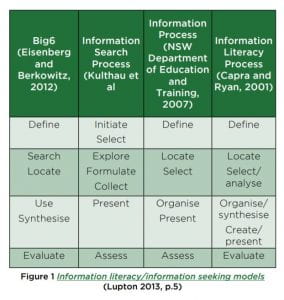
There are several information literacy (IL) models that are available to assist with the information search process. The models recommended here are research based models, although many other IL models abound as people blend components of different models to cater for student needs.
An IL models teaches students steps to take to gain understanding of a question (Fitzgerald, 2015, p.18). Some of the more common models according to Herring (2007, p.33) are Kuhlthau’s information Search Process (ISP), the Information Literacy Planning Overview (ILPO ), Big 6 and the PLUS model. In addition to this list there are also the NSW ISP model by the NSW Department of Education and the Guided Inquiry Design – an updated model of Kuhlthau’s ISP model.
Sometimes elements of models are combined together by TLs to enhance the learning benefits of one particular model, such the Library Learning Path (Barker, Bennett & Gittins, 2016).
All of the IL models have common elements as this table by Lupton shows:

One of the standout IL models for me is the GID, because it integrates the ISP elements of affective, cognitive and physical with the phases of Guided Inquiry and allows for the creation of the third space for students. Using GID also allows for assistance in each stage of the ISP through the zone of intervention – an area where students are unable to proceed alone or only with difficulty and require advice and assistance. (Kuhlthau, Maniotes & Caspari, 2012).
The IL model you choose to use depends on several factors – namely time, resources and school cultures. The GID model can be particularly intense on teacher resources, resources and a culture of inquiry and collaboration. The IL model needs to work for your school circumstances but O’Connell (2012) states it is the TL who is able to tie together the knowledge of the resources available – physical, community and online.
References:
Barker, L., Bennett, B., & Gittins, K. (2016). The library. Mrs Barker’s team room [blog post]. Retrieved from https://mrsbarkerstearoom.com/?page_id=303
Fitzgerald, L. (2015). Guided inquiry in practice. Scan, 34 (4). Retrieved from https://education.nsw.gov.au/teaching-and-learning/professional-learning/scan/media/documents/vol-34/Research-Guided-inquiry-in-practice.pdf
Herring, J. (2007). Teacher librarians and the school library. In S. Ferguson (Ed.) Libraries in the twenty-first century : charting new directions in information (pp. 27-42). Wagga Wagga , NSW : Centre for Information Studies, Charles Sturt University. Retrieved from https://www-sciencedirect-com.
Kuhlthau, C., Maniotes, L. & Caspari, A. (2012). Guided inquiry design: A framework for inquiry in your school. Retrieved from http://ebookcentral.proquest.com
Lupton, M. (2013). Inquiry pedagogy and the Australian Curriculum. Primary and Middle Years Educator, 11(2), 23-29. Retrieved from https://eprints.qut.edu.au/65829/2/65829.pdf
O’Connell, J. (2012). So you think they can learn? Scan, 31. Retrieved from https://heyjude.files.wordpress.com/2006/06/joc_scan_may-2012.pdf
